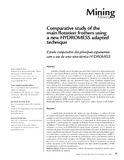| dc.creator | Veras, Moacir Medeiros | |
| dc.creator | Baltar, Carlos Adolpho Magalhães | |
| dc.creator | Paulo, João Bosco de Araújo | |
| dc.creator | Leite, José Yvan Pereira | |
| dc.date.accessioned | 2015-11-04T03:04:50Z | |
| dc.date.available | 2014-03 | |
| dc.date.available | 2015-11-04T03:04:50Z | |
| dc.date.issued | 2014-03 | |
| dc.identifier.citation | Veras, Moacir Medeiros, Baltar, Carlos Adolpho Magalhães, Paulo, João Bosco de Araújo, & Leite, José Yvan Pereira. (2014). Comparative study of the main flotation frothers using a new HYDROMESS adapted technique. Rem: Revista Escola de Minas, 67(1), 87-92. Retrieved October 29, 2015, from http://www.scielo.br/scielo.php?script=sci_arttext&pid=S0370-44672014000100013&lng=en&tlng=en. | pt_BR |
| dc.identifier.issn | 0370-4467 | pt_BR |
| dc.identifier.uri | http://memoria.ifrn.edu.br/handle/1044/354 | |
| dc.description.abstract | Stability of bubble size in the pulp zone and froth control is an important parameter for a successful flotation process. The present study compares the action of the main frothers in terms of: mean bubble size in the pulp zone, froth stability, surface-tension-lowering ability and reagent participation in flotation of a naturally hydrophobic mineral. Bubble size was determined using a new technique adapted from HYDROMESS, a device designed to measure drop size. The remaining indicators were obtained by determining surface tension and conducting flotation tests with the addition of hydrophobic (graphite) and hydrophilic (calcite) particles. The results indicate that methyl isobutyl carbinol (MIBC) is the most efficient frother in controlling coalescence, with critical coalescence concentration (CCC) reached at 20 ppm. Moreover, this frother has greater potential for selective action, since it increased calcite entrainment by only 2.3% at a concentration of 30 ppm. In flotation tests with a sample of graphite, MIBC produced higher recoveries. | pt_BR |
| dc.language | eng | pt_BR |
| dc.publisher | Insitituto Federal de Educação, Ciência e Tecnologia do Rio Grande do Norte | pt_BR |
| dc.relation.ispartof | Revista Escola de Minas | pt_BR |
| dc.rights | Acesso Aberto | pt_BR |
| dc.subject | flotation, frother, froth control, coalescence, surface tension, froth stability. | pt_BR |
| dc.title | Comparative study of the main flotation frothers using a new HYDROMESS adapted technique | pt_BR |
| dc.type | Artigo de Periódico | pt_BR |
| dc.publisher.country | Brasil | pt_BR |
| dc.publisher.department | Natal - Central | pt_BR |
| dc.publisher.initials | IFRN | pt_BR |
| dc.subject.cnpq | engenharia de minas | pt_BR |
| dc.citation.volume | 67 | pt_BR |
| dc.citation.issue | 1 | pt_BR |
| dc.citation.spage | 87 | pt_BR |
| dc.citation.epage | 92 | pt_BR |
| dc.description.resumo | Stability of bubble size in the pulp zone and froth control is an important parameter for a successful flotation process. The present study compares the action of the main frothers in terms of: mean bubble size in the pulp zone, froth stability, surface-tension-lowering ability and reagent participation in flotation of a naturally hydrophobic mineral. Bubble size was determined using a new technique adapted from HYDROMESS, a device designed to measure drop size. The remaining indicators were obtained by determining surface tension and conducting flotation tests with the addition of hydrophobic (graphite) and hydrophilic (calcite) particles. The results indicate that methyl isobutyl carbinol (MIBC) is the most efficient frother in controlling coalescence, with critical coalescence concentration (CCC) reached at 20 ppm. Moreover, this frother has greater potential for selective action, since it increased calcite entrainment by only 2.3% at a concentration of 30 ppm. In flotation tests with a sample of graphite, MIBC produced higher recoveries. | pt_BR |




